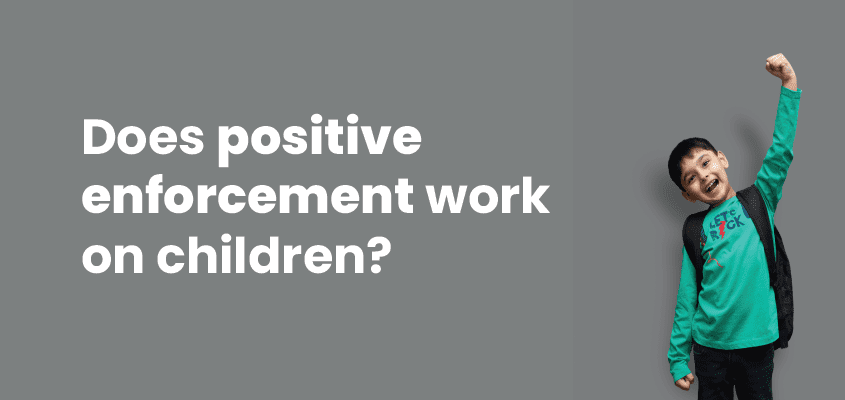Introduction
Positive enforcement of children is more effective in shaping their behaviour than punishment. A new study, however, suggests that the child’s age may play a role in how responsive they are to different types of reinforcement. The study, conducted by researchers at the University of Washington, looked at children between the ages of 3 and 5 to see how they responded to positive and negative reinforcement. The results showed that younger children were more responsive to positive reinforcement, while older children were more responsive to negative reinforcement. While the study did not specifically look at the effects of positive reinforcement on children’s behaviour, it does suggest that younger children may be more receptive to this type of reinforcement.
What is positive enforcement on children?
Positive reinforcement is a parenting technique that promotes good behaviour. Praise your children for their desirable behaviour or encourage them to continue exhibiting it. Positive reinforcement can include verbal praise, tangible rewards, and privileges. The goal is to encourage children to continue demonstrating good behaviour by associating it with positive outcomes.
What is the way to implement positive enforcement on children?
If you want positive enforcement on children, many resources are available to help you get started; articles and websites offer tips and advice on effectively using this parenting tool. You can also talk to your child’s doctor or other healthcare positive reinforcement, and they can provide additional guidance.[1]]
There are many different ways to implement positive enforcement on children:
- One standard method is to use praise or verbal rewards for the desired behaviours.
- Another popular approach is to provide tangible rewards for good behaviour, such as stickers, small toys, or points that can be redeemed for prizes.
- When using positive enforcement on children, it is essential to use rewards and praise consistently, and inconsistent reinforcement can lead to more problematic behaviour from children.
- It is also necessary to avoid using punishment to try to achieve the desired results with positive reinforcement – this will only undermine the technique’s effectiveness.
The Impacts of Negative reinforcement
- Negative reinforcement removes an unpleasant or aversive stimulus to strengthen desired behaviour.
- It differs from positive reinforcement, which adds a reward or positive stimulus.
- Negative reinforcement aims to increase the likelihood of desirable behaviour.
- It is widely used in child development, along with positive reinforcement and punishment.
- It involves removing an unpleasant or aversive stimulus to strengthen a desired behaviour. Unlike positive reinforcement, which includes adding a reward or positive motivation, negative reinforcement involves taking something away to promote good behaviour.
The Impact of positive enforcement on children
Reinforcement, both positive and negative, can impact children’s behaviour. However, the effects of positive enforcement on children are robust and long-lasting.[2]In other words, it is a way of rewarding good behaviour and encouraging it more. There are many ways to deliver positive reinforcement, including verbal praise, physical affection, stickers, or privileges such as extra screen time.
The effects of positive enforcement on children, the findings are clear:
- Children who receive positive reinforcement for their excellent behaviour are likelier to continue exhibiting it. In contrast, those who do not receive positive reinforcement are less likely to continue displaying the desired behaviour.
- All human beings are motivated by rewards (positive reinforcement) and punishments (negative reinforcement). We are wired to repeat behaviours that result in pleasant outcomes and avoid those that lead to unpleasant consequences.
- When it comes to children, this principle applies even more strongly because they are still learning what behaviour will result in what consequences. Therefore, we must provide them with clear feedback about which behaviours are desirable and which are not.
- Positive reinforcement is a powerful technique for influencing children’s behaviour as it effectively communicates the desired actions that we want them to repeat in the future.
How to use positive reinforcement effectively
There are four key elements to using positive enforcement on children effectively[3]:
1. Choose the correct behaviour to reinforce: Positive reinforcement should encourage desired behaviours, such as completing a task or following directions.
2. Make sure the reinforcement is immediate: The best way to reinforce a behaviour is to provide support immediately after the desired behaviour is displayed. For children to connect the two, they must see the consequence (reinforcement) happen after they perform the desired behaviour.
3. Make the reinforcement desirable: For positive reinforcement to have an effect, children must be motivated by what you offer them. For example, if you are trying to encourage your child to tidy up their room, offering them their favourite toy as a reward is more likely to be effective than providing them with a less desirable reward, such as an extra bedtime story.
4. Vary the reinforcer to keep the child interested: It is essential to vary the reinforcer you use to keep children interested in the desired behaviour. For example, suppose you are using candy as a reinforcer for good behaviour. In that case, you will need to offer different types of candy or different amounts over time to avoid your child becoming bored with the reinforcement.
Examples of positive enforcement on children
There are many ways to provide positive enforcement on children. Some common examples include:
- Verbal praise
- Awards
- Privileges
- Tangible rewards.
When used consistently and appropriately, positive reinforcement can effectively encourage desired behaviours in children. It can also help build a child’s self-esteem and confidence.
When positive reinforcement isn’t enough
Parents often rely on positive reinforcement to encourage good behaviour when raising children. However, there are times when positive reinforcement isn’t enough to get your child to comply with your wishes. In these cases, you may need to resort to other tactics, such as negative reinforcement or punishment.
Negative reinforcement is a technique in which you remove something unpleasant after your child demonstrates the desired behaviour. For example, if your child throws a tantrum whenever he doesn’t get his way, you may give in to his demands to avoid drama. Over time, kids learn that throwing a tantrum gets them what they want, and they will be more likely to repeat the behaviour. On the other hand, punishment involves doing something unpleasant after your child misbehaves.
For example, if your child hits his sister, you may put him in timeout or take away his favourite toy. Punishment aims to make your child understand that there are consequences for his actions and that he needs to change his behaviour behaviour behaviour to avoid unpleasant effects. Sometimes parenting counselling helps you in this matter. You can contact our parenting counselling experts at United We Care if you wish to learn more about the positive enforcement of children and how to master it. Contact us today to learn more!
References
- E. A. Sigler and S. Aamidor, “From positive reinforcement to positive behaviours: An everyday guide for the practitioner,” Early Child. Educ. J., vol. 32, no. 4, pp. 249–253, 2005.
- J. P. Rushton and G. Teachman, “The effects of positive reinforcement, attributions, and punishment on model induced altruism in children,” Pers. Soc. Psychol. Bull., vol. 4, no. 2, pp. 322–325, 1978.
- J. K. Hardy and R. H. McLeod, “Using positive reinforcement with young children,” Beyond Behav., vol. 29, no. 2, pp. 95–107, 2020.





